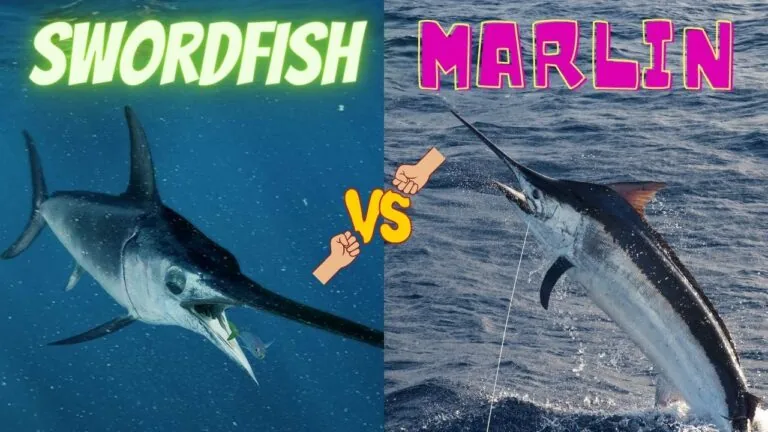Get ready to dive into the exciting world of billfish! We’ll be pitting Marlin against Swordfish in a battle of the bills. These fascinating fish share the same family, with their sharp, spear-like bills used to slice through schools of smaller prey.
But what makes them stand out from each other? Join us as we explore the key differences between these two intriguing species in this must-read article.
Table of Contents
- Swordfish Vs. Marlin Short Explainer Video
- Billfish Comparison Chart- Swordfish vs. Marlin
- Swordfish Vs. Marlin Image (Comparison)
- Interesting Facts About Swordfish:
- Interesting Facts about Marlin:
- Marlin Vs. Swordfish (Infographic)
- Swordfish vs. Marlin (Conclusion)
- FAQ’s
- What is the difference between a sailfish and a marlin?
- What are the reproductive habits of Swordfish and Marlin?
- How do Swordfish and Marlin use their bills?
- How do Swordfish and Marlin adapt to different water temperatures?
- What are the international regulations on Swordfish and Marlin fishing?
- What are some popular Swordfish and Marlin fishing tournaments?
- How do Swordfish and Marlin communicate?
- What are some myths or legends associated with Swordfish and Marlin?
Swordfish Vs. Marlin Short Explainer Video
Billfish Comparison Chart- Swordfish vs. Marlin
| Feature | Swordfish | Marlin |
|---|---|---|
| Size | Generally smaller | Generally larger |
| Appearance | Rounded body, flattened bill | Slender, tubular body, spear-like bill |
| Diet | Feeds on smaller fish and cephalopods; hunts in deeper waters | Feeds on smaller fish and cephalopods; stays near the surface |
| Dorsal fin | Modest, elongated dorsal fin | Distinctive, sail-like dorsal fin |
| Habitat | Typically Found in Deeper waters | Swim in deeper waters but spend most of their time in shallow waters |
| Scale and Skin Characteristics | Scales present until around 3 feet long | Swim in deeper waters but spend most of their time in shallow |
| Dental Features | Teeth absent in adults; relies on sharp bill | Small, file-like teeth present; also uses bill |
| Speed | Up to 60 mph | potentially up to 100 mph, most likely 60 mph |
| Taste of Meat | Sweeter, less fatty | Higher fat content, slightly stronger flavor |
| Maturity and Lifespan | Mature at 5-6 years; lifespan of around 9 years | Mature at 5-6 years; lifespan of around nine years |
1. Appearance (Sword & Bill)
While both marlin and swordfish belong to the same billfish family, they have distinct differences in appearance. Marlin have a more slender and tubular body, while swordfish have a rounded body.
Shape and Structure
Marlin’s Bill: Marlin bills are round and slender, tending to be more flexible, and taper to a sharper point. They’re covered in tiny, round, rough scales. The bill’s length can be roughly one-third of the marlin’s body length.
Swordfish’s Bill: Swordfish bills are broader and flatter in comparison, appearing more like a long, double-edged sword. They tend to be slightly shorter and sturdier than marlin bills, and the surface of the bill is smooth.
Use of Bill Against Prey
Both marlins and swordfish use their bills as a hunting tools, but their methods differ somewhat.
Marlin’s Bill: Marlins tend to use their bills to slash at schools of fish, stunning or wounding them, which makes it easier to catch and eat their prey.
Swordfish’s Bill: While there is ongoing research and debate over the precise use of the swordfish’s bill, it’s suggested that they use their sturdier bills to charge at schools of fish, using it more like a battering ram to stun or kill their prey. Some studies also suggest that swordfish may use their bills to cut through the water, improving hydrodynamics.
2. Size
Marlin Size: Marlin can reach a size of up to 16ft in length and 1,800 or more pounds (According to Wikipedia). Avg length is 7-12ft.
Swordfish Size: Swordfish can reach up to 14ft in Length and the record Swordfish ever caught was 1,430 pounds (according to Wikipedia). Avg length is 10ft.
As predatory fish, both Marlin and Swordfish are very big; however, a swordfish is smaller than a marlin, with black marlin being the largest among marlin species. Don’t get me wrong, adult swordfish can reach a sizable length and weight themselves but typically do not reach the same dimensions as marlin.
3. Eating
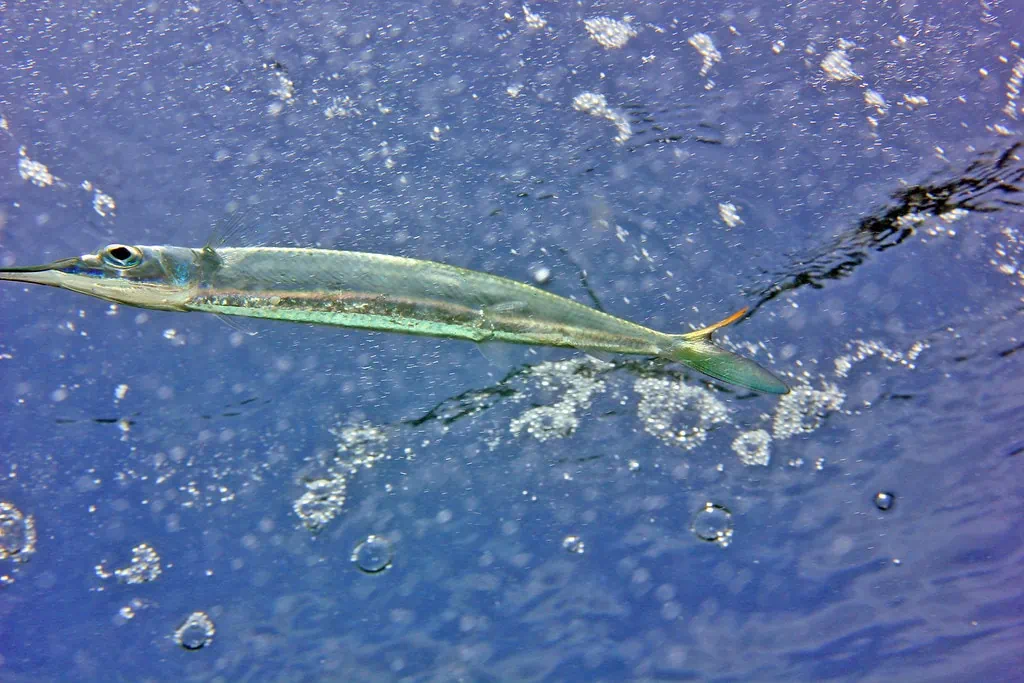
All Billfish are predatory fish, feeding on smaller fish and cephalopods. However, swordfish are known to venture into deeper waters to hunt for prey, while marlin typically stay near the surface. This is why Marlin fishing generally involves trolling bait near the surface, and Swordfishing involves deep-dropping on electric reels, usually with squid.
4. Dorsal fin
Marlin have a distinctive, sail-like dorsal fin that runs along the length of their back. This dorsal fin is quite tall and can be raised or lowered as the marlin swims, giving the fish a distinctive profile in the water. The sail-like shape of the fin is thought to help marlin regulate their body temperature by absorbing heat from the sun, and it also helps them maneuver through the water with precision.
In contrast, the dorsal fin of swordfish is more elongated and smaller. It runs along the top of the fish’s back, providing stability and balance while swimming. Although not as distinctive as the marlin’s sail-like dorsal fin, it is still an important feature that helps swordfish thrive in their ocean environment.
5. Pectoral Fin
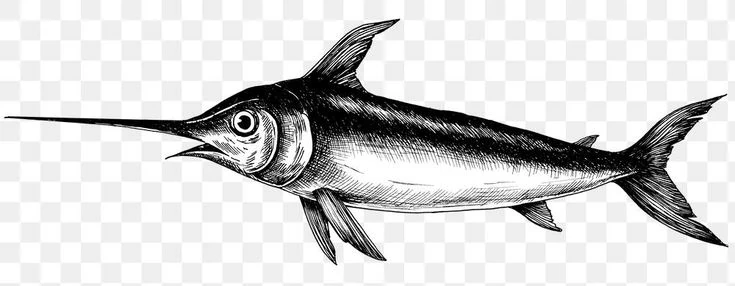
In general, the pectoral fins of both swordfish and marlin are relatively long and narrow, with a pointed shape that helps the fish move quickly through the water. However, there are some subtle differences between the two species:
- Swordfish pectoral fins tend to be larger and more triangular in shape, with a more pronounced curve at the base. They may also have a slightly different texture, with a rougher surface that helps to reduce drag as the fish swims.
- Marlin pectoral fins, on the other hand, are slightly smaller and more rounded, with a less pronounced curve at the base. They may also be more flexible than swordfish fins, allowing the fish to make more precise movements and maneuvers.
5. Habitat

Both marlin and swordfish are highly migratory and can be found in the Atlantic, Pacific, and Indian Oceans. They traverse both tropical and temperate waters depending on the availability of food and breeding grounds.
6. Scales and Skin
A notable distinction between marlin and swordfish can be observed in their skin and scales. Swordfish possess scales only until they grow to around 3 feet long, whereas marlin are covered in elongated, dense, bony scales throughout their lives. Marlin also exhibit a unique hexagonal pattern on their sides, a part of their lateral line system that allows them to sense changes in water pressure.
7. Dental Features
While adult swordfish lose their teeth, marlin maintain small, file-like teeth in both their jaws and the palatine or the roof of their mouths. Adult swordfish rely solely on their sharp bills to kill prey, swallowing them whole.
8. Speed
Marlin: According to some, the black marlin is possibly the fastest fish in the ocean, supposedly reaching speeds close to 100 mph. However, that has not been proven!
Swordfish: As for the Swordfish, it has a large, oily gland at the base of its bill that reduces friction drag and enhances swimming efficiency up to 60mph; that being said, it still cannot compete with the speed of a Blue marlin or a Black marlin.
9. Taste

If you were to eat Marlin or Swordfish, you would find they both have a dense texture, similar to tuna, and a comparable taste. Swordfish flesh is somewhat lighter than marlin’s, which has a higher fat content and a slightly stronger flavor.
Swordfish is sweeter and less fatty. The best way to enjoy swordfish is grilled as fillets, pan-fried, or served raw as sashimi. Marlin can also be prepared in sashimi-style dishes, such as carpaccio or poke, or seared and served rare, like a tuna steak. However, it’s crucial to be aware that both fish can contain elevated toxin levels, including mercury, due to their status as top-level predatory fish.
10. Maturity and Lifespan
Swordfish attain sexual maturity at the age of five to six years, while blue marlin reach maturity much earlier, between two and four years of age. The lifespan of a swordfish is considerably shorter, at around 9 years, while female marlin can live up to 20 years and males for about 10 years.
11. Lifespan
Swordfish: live up to 15 years, but the average lifespan in the wild is around 9 years. Factors like natural predators, such as sharks, and human fishing activities can impact their survival.
Marlin: The lifespan of a marlin can vary depending on the species, but they typically live for around 10 to 15 years in the wild. Factors such as predation by sharks and human fishing activities can impact their survival rates.
12. Fishing for Marlin and Swordfish (Differences)
- Marlin fishing: Typically involves trolling baited lines behind a boat at a slow speed and occasionally live bait if you want a really big fish. Trolling allows the bait to move through the water naturally, attracting marlin to strike. Once a marlin is hooked, it can take a few minutes to several hours to land, depending on the size and strength of the fish.
- Swordfishing: On the other hand, Swordfishing is usually done in deeper waters using specialized gear such as electric reels and light sticks. Anglers often use baits that glow or make sounds to attract swordfish to strike, as these fish dwell deep underwater and are less likely to be caught on the surface. Once hooked, swordfish can put up an intense fight that can last several hours.
You might be interested in reading: When is Marlin Fishing Season
Swordfish Vs. Marlin Image (Comparison)
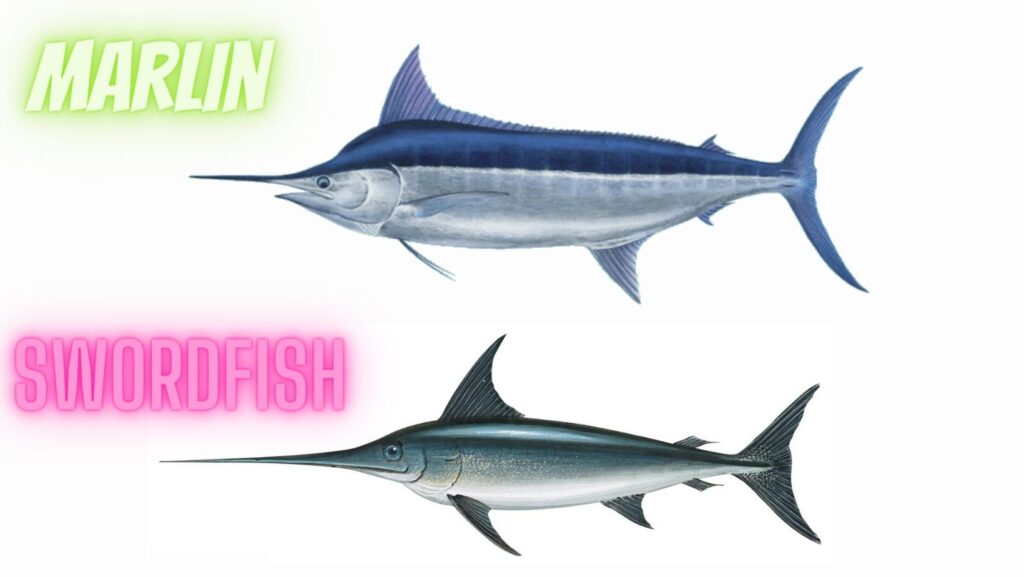
Interesting Facts About Swordfish:
- Swordfish are known for their excellent vision, which allows them to hunt effectively in deep water.
- They are popular among sport fishermen due to their size and speed.
- Swordfish meat has a firm flesh and a milder flavor compared to marlin, making it a popular choice for dishes like swordfish steaks and sashimi style preparations.
Interesting Facts about Marlin:
- Marlin fishing is popular among sport fishermen due to the fish’s speed, strength, and size.
- Marlin meat has a stronger flavor compared to swordfish, and it is often prepared in thin slices as sashimi or cooked in larger chunks like a tuna steak.
- The color of marlin flesh varies depending on the species, with some having pink flesh while others are considerably lighter.
- The size of marlin varies greatly between species, with the black marlin being the largest, capable of reaching over 1,500 pounds (680 kg), while the white marlin is smaller, averaging around 100 pounds (45 kg).
Marlin Vs. Swordfish (Infographic)
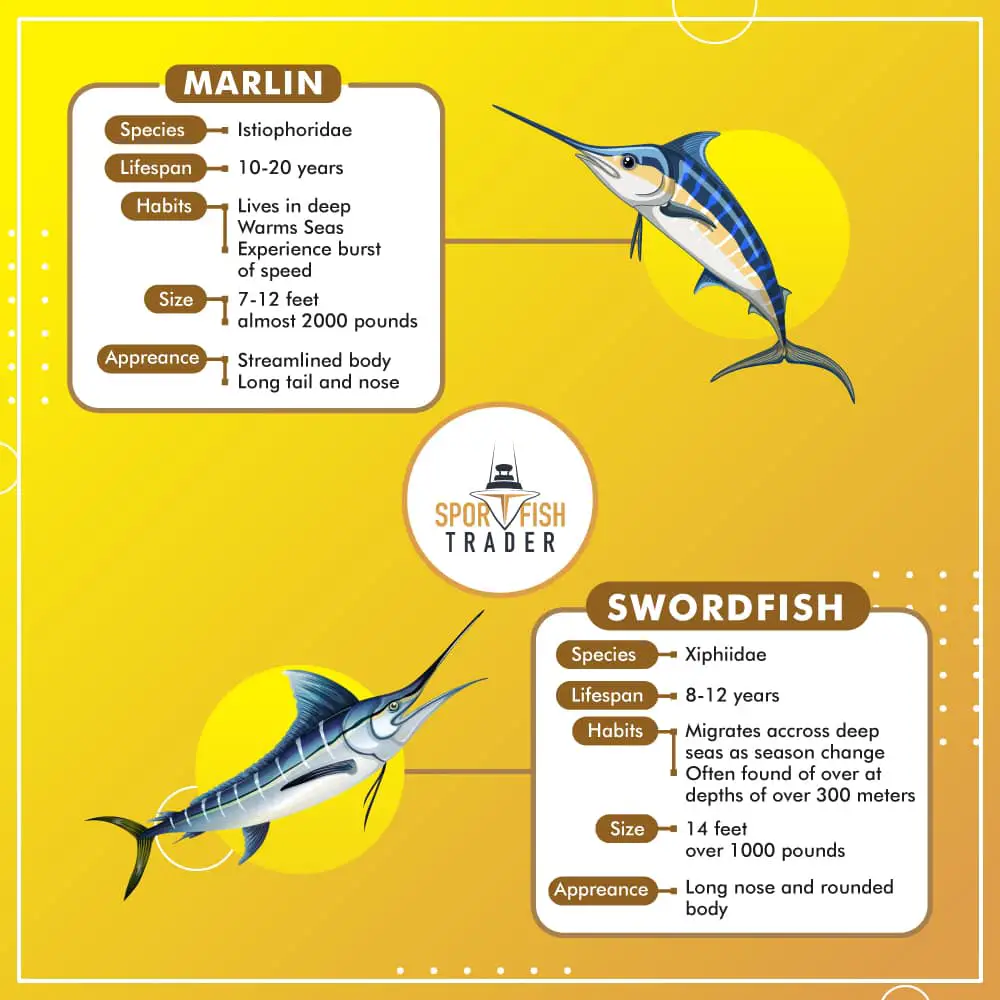
Swordfish vs. Marlin (Conclusion)
Swordfish and marlin exhibit key differences while belonging to the same billfish family. Despite their close relationship, these characteristics help distinguish the two species from each other.
Understanding the differences between swordfish and marlin is crucial for sport fishermen, researchers, and those interested in learning about these fascinating fish. Recognizing their unique traits not only deepens our appreciation for the diversity of marine life but also helps us make informed decisions about conservation and sustainable fishing practices.
FAQ’s
What is the difference between a sailfish and a marlin?
Sailfish and Marlin, while similar, have distinct differences. Sailfish, named for their larger, sail-like dorsal fins, tend to move and hunt in groups. They can grow up to 10 feet long and weigh up to 220 pounds. On the other hand, Marlin, known for their dorsal fin that peaks at the front and gently slopes downward, are generally loners. They can grow up to 12 feet long and weigh up to 2,000 pounds. The physical differences, hunting behaviors, and size are key distinguishing factors between these two species.
What are the reproductive habits of Swordfish and Marlin?
Both Swordfish and Marlin are known to spawn in warmer waters, with females releasing millions of eggs that males then fertilize.
How do Swordfish and Marlin use their bills?
Both Swordfish and Marlin use their bills as a hunting tool. They can use them to stun their prey by slashing their bills side to side, making it easier to catch their stunned prey. This behavior is often referred to as “bill sweeping.”
How do Swordfish and Marlin adapt to different water temperatures?
Swordfish and Marlin are both capable of regulating their body temperatures, a phenomenon known as regional endothermy. This allows them to adapt to a variety of water temperatures and enables them to hunt in both warm surface waters and colder, deeper waters.
What are the international regulations on Swordfish and Marlin fishing?
International regulations aim to manage and conserve Swordfish and Marlin populations. These often involve quotas, which limit the number of fish that can be caught, and size limits, which protect younger fish until they have had a chance to reproduce. These regulations are often enforced through permits and reporting requirements.
What are some popular Swordfish and Marlin fishing tournaments?
There are numerous fishing tournaments worldwide that feature Swordfish and Marlin. These tournaments often involve large prizes and attract participants from around the world. Examples include the White Marlin Open in Ocean City, MD and the Big Rock Blue Marlin Tournament in Morehead City, North Carolina.
How do Swordfish and Marlin communicate?
Swordfish and Marlin communicate primarily through body movements. For example, changes in swimming patterns or the positioning of their fins can signal different intentions or states. Some species of Marlin are also known to change color, which is thought to play a role in communication. However, research in this area is still ongoing.
What are some myths or legends associated with Swordfish and Marlin?
Swordfish and Marlin feature in various cultural myths and legends around the world. In some cultures, they are seen as symbols of strength and speed. For example, in Hawaiian mythology, the god Kanaloa is often depicted with a Marlin spear. These stories reflect the respect and fascination these species have inspired in humans throughout history.

